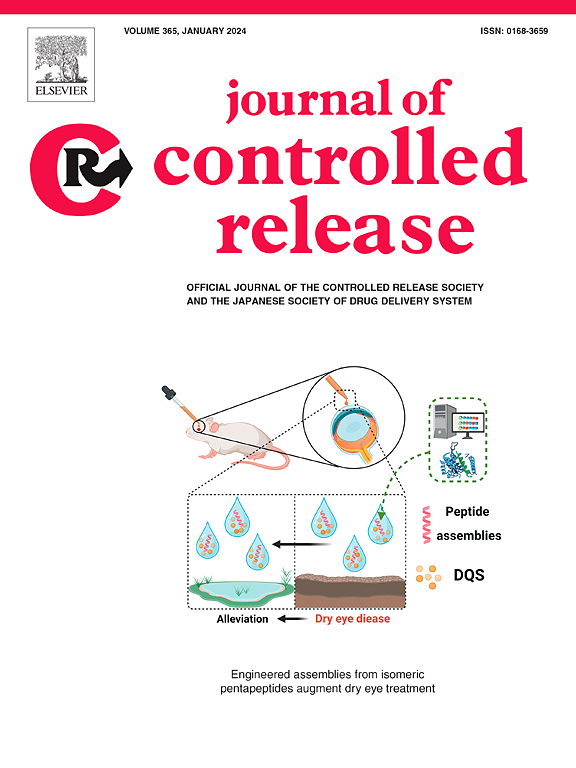基于核酸的纳米凝胶具有“进攻和防御”作用,用于增强化学免疫治疗
IF 10.5
1区 医学
Q1 CHEMISTRY, MULTIDISCIPLINARY
引用次数: 0
摘要
化疗药物如阿霉素(DOX)可以通过诱导免疫原性细胞死亡(ICD)激活CD8+ T细胞介导的抗肿瘤免疫应答,证明了化疗-免疫协同治疗的潜力。然而,肿瘤抗原的持续刺激引发CD8+ T细胞的衰竭,成为抑制肿瘤生长和转移的主要障碍。T细胞浸润和耗竭的双重调控引发强大的免疫反应是优化肿瘤免疫治疗的关键。在这项研究中,开发了一种膜包被的框架核酸纳米凝胶(RM@NG/DOX),用于共同递送DOX和siRNA (siTOX,胸腺细胞选择相关的高迁移率组盒蛋白,TOX),用于化学免疫治疗的时空协同调节。该系统打破了传统的siRNA阳离子载体传递模式,构建了双层屏障,进一步保护负载的siTOX和DOX。RM@NG/DOX通过DOX作为“进攻性”信号诱导ICD,增强T细胞浸润,而siTOX作为“防御模块”通过沉默T细胞衰竭的关键调节因子TOX,逆转疲惫T细胞(PD-1+ Tim-3+)的分化。体外和体内实验证实,RM@NG/DOX通过“激活-逆转”双重途径重塑免疫微环境,有效抑制肿瘤生长和转移,成功将“冷瘤”转化为免疫浸润的“热瘤”,增强化学免疫治疗。综上所述,基于核酸纳米凝胶的化学-遗传联合纳米药物为化学免疫治疗和T细胞衰竭调节提供了一种新的策略。本文章由计算机程序翻译,如有差异,请以英文原文为准。


Nucleic acid-based nanogels with “offensive and defensive”effects for enhanced chemo-immunotherapy
Chemotherapeutic drugs such as doxorubicin (DOX) can activate CD8+ T cell-mediated antitumor immune responses by inducing immunogenic cell death (ICD), demonstrating the potential of chemo-immune synergistic therapy. However, the continuous stimulation of tumor antigens triggers the exhaustion of CD8+ T cells, which has become the main obstacle to inhibiting tumor growth and metastasis. Dual regulation of T cell infiltration and exhaustion to elicit a robust immune response is the key for optimizing tumor immunotherapy. In this study, a membrane-coated framework nucleic acid-based nanogel (RM@NG/DOX) was developed to co-deliver DOX and siRNA (siTOX, thymocyte selection-associated high mobility group box protein, TOX) for the spatiotemporal synergistic regulation of chemo-immunotherapy. This system broke the traditional cationic carrier mode of siRNA delivery and constructed a double-layer barrier to further protect the loaded siTOX and DOX. RM@NG/DOX induced ICD by DOX as an “offensive” signal to enhance T cell infiltration, while siTOX as a “defensive module” reversed the differentiation of exhausted T cells (PD-1+ Tim-3+) by silencing TOX, a key regulator of T cell exhaustion. Experiments in vitro and in vivo confirmed that RM@NG/DOX reshaped the immune microenvironment through the dual pathway of “activation-reversal” to effectively inhibit tumor growth and metastasis, successfully transforming the “cold tumor” into an immune-infiltrated “hot tumor” and enhancing chemo-immunotherapy. In summary, the combined chemo-genetic nanomedicine based on nucleic acid nanogels provides a new strategy for chemo-immunotherapy and the regulation of T cell exhaustion.
求助全文
通过发布文献求助,成功后即可免费获取论文全文。
去求助
来源期刊

Journal of Controlled Release
医学-化学综合
CiteScore
18.50
自引率
5.60%
发文量
700
审稿时长
39 days
期刊介绍:
The Journal of Controlled Release (JCR) proudly serves as the Official Journal of the Controlled Release Society and the Japan Society of Drug Delivery System.
Dedicated to the broad field of delivery science and technology, JCR publishes high-quality research articles covering drug delivery systems and all facets of formulations. This includes the physicochemical and biological properties of drugs, design and characterization of dosage forms, release mechanisms, in vivo testing, and formulation research and development across pharmaceutical, diagnostic, agricultural, environmental, cosmetic, and food industries.
Priority is given to manuscripts that contribute to the fundamental understanding of principles or demonstrate the advantages of novel technologies in terms of safety and efficacy over current clinical standards. JCR strives to be a leading platform for advancements in delivery science and technology.
 求助内容:
求助内容: 应助结果提醒方式:
应助结果提醒方式:


